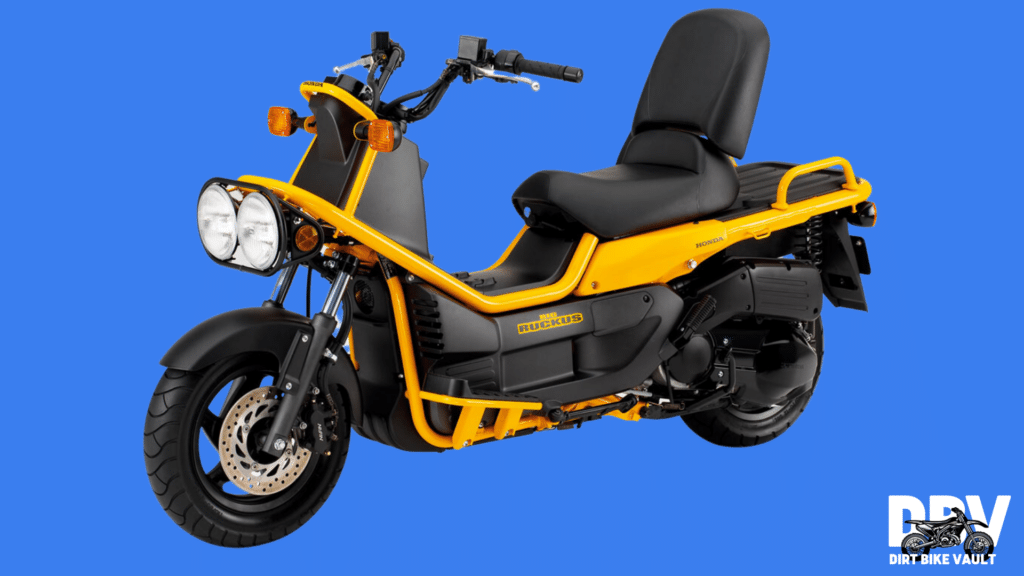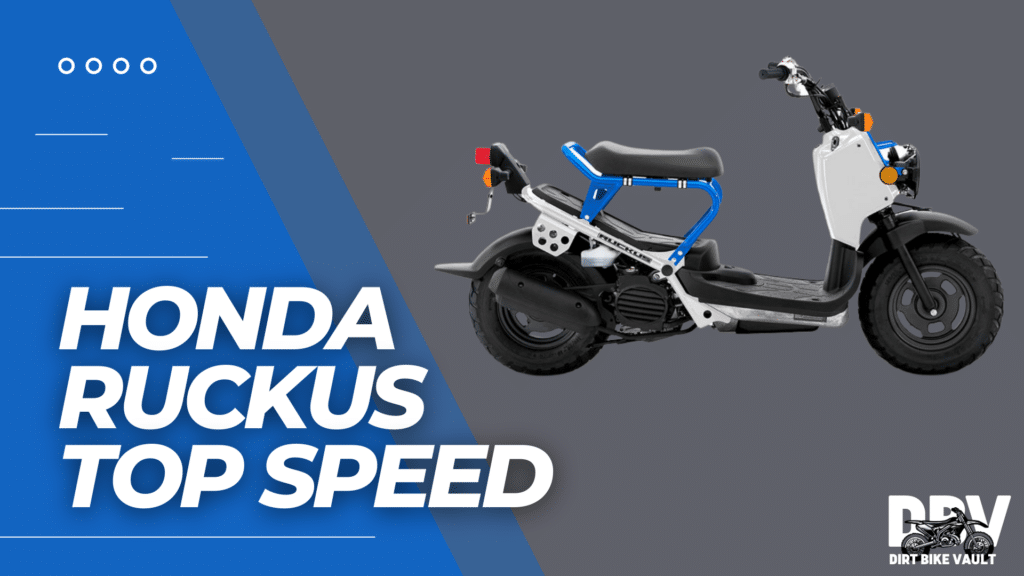The Honda Ruckus has been around for over 20 years at this point, and for reasons beyond all human understanding, it’s only gotten cooler with time. That’s a particularly impressive point considering the little ‘Ruck has remained almost entirely unchanged since its introduction in 2001 (2003 in the US), so if you’re looking to find the Honda Ruckus’ top speed, the good news is that the answer is the same regardless of which model you’re riding.
Honda Ruckus Top Speed
The Honda Ruckus is built around a very small (49cc) single-cylinder engine, and as such, its top speed varies by a few mph depending on several conditions including rider weight, road quality, and wind speed. With that being said, your typical Honda Ruckus top speed is about 40mph, at which point the little 4-5 hp engine runs out of steam, RPMs, or both.
It’s possible to increase the Honda Ruckus’ top speed by a few MPH with a handful of simple bolt-on modifications (more on that below), but this little scoot was never intended to be a speed demon, and most owners spend the majority of their time comfortably cruising around 30 mph.
We will note that the Ruckus got its one major update in 2006 which included a revised crankcase ventilation system, a higher redline (boosted from 8000 to 8850 rpm), and an upgraded exhaust, so the pre-2006 models top out a bit lower, around 35 mph by most reports.
Honda Big Ruckus Top Speed
If you’re loving the Ruckus style but want something with a little more power, chances are you’re considering the 250cc version, the Honda Big Ruckus. While this model was exceptionally short-lived (it was only produced from 2005-2006 in the US), it does benefit from a much higher top speed.

Big Ruckus owners have reported top speeds as high as 80 mph, although typical real-world top speed is closer to about 70 mph. With that being said, this is still a small displacement scooter at heart with minimal wind protection and very small wheels/tires, so you should expect anything over about 60mph or so to feel a bit sketchy.
How long to reach the top speed on a Honda Ruckus?
Assuming you’re a relatively average-sized person on a bone stock Ruckus, reaching speed on a Honda Ruckus can take anywhere from 20 seconds to a full minute. Much of this depends on the riding conditions (elevation, gradient, wind speed, etc.) but generally speaking you’re looking at about 10 seconds of relatively constant acceleration up to about 30 mph, then a very slow climb to somewhere in the neighborhood of that 40mph top speed we discussed above.
What changes the top speed of the Honda Ruckus?
There are three major things you can do to change the top speed of your Honda Ruckus: adding power, subtracting weight, and modifying the final drive ratio. As is the case with any two-wheeler, there are countless ways to go about this, but here are the six most common ways owners add a few extra mph to the Ruckus.
Honda Ruckus Top Speed Modifications
Airbox Delete
One of the single most effective ways you can get your Ruckus closer to highway speeds is by opening up its restrictive air intake system. The quickest and easiest way to do this is to replace the factory air filter with a free-flowing aftermarket filter, ideally something like a pod filter from the folks at UNI or any one of the dozen copycat oil and foam filters currently on the market.
Most Ruckus owners don’t stop there though, which is why removing the airbox entirely is a popular upgrade. Completely removing the airbox and replacing it with a simple hose and pod filter setup drastically improves engine breathability, and also reduces clutter under the seat to give your Ruck a cleaner custom look.
Aftermarket Exhaust
There are plenty of good reasons to swap out the Ruckus’ factory exhaust for an aftermarket unit, and top speed is one of them. The stock pipe Honda fits to the Ruckus weighs somewhere north of 12 lbs, and a good aftermarket system will cut that weight by more than half.
Aftermarket pipes are also much less restrictive than factory systems and play an important role in boosting power when used in conjunction with the upgraded air intake described above and an upgraded fuel delivery system (more on that below). Keep in mind, however, that if you go with an overly open exhaust system, you’ll actually lose power compared to the factory unit.
Most Ruckus owners seem to agree that when using the factory carburetor, the largest diameter exhaust you’ll want to run is 16mm, and anything larger than that will require more drastic modifications, tuning, and investment.
Aftermarket Variator
All Honda Ruckus scooters use a belt-driven automatic CVT transmission to transmit power to the rear wheel. That means that unlike typical motorcycles, where changing the chain and sprockets can improve either your acceleration or your top speed, you’ll have to change a special part called a “variator” to achieve similar results.
Without getting too deep into the details, one of the benefits that a CVT and variator setup has over a conventional chain and sprocket combo is that by replacing the variator and the weights that control its movement, Ruckus owners can improve both acceleration and top speed simultaneously with the right setup.
Rejet the Carburetor
If you’re going to start modifying your intake and exhaust to get your engine flowing freely, don’t forget you’ll also need to tune or “rejet” your carburetor to match. By swapping out the jets inside the factory carb, you’re effectively matching the flow of fuel being fed to the engine with the increased volume of air from the intake, which will increase power, improve throttle response, and smooth out power delivery.
Failing to match your carb’s performance to your intake/exhaust setup will create an excessively lean condition, which is what we want to avoid. You shouldn’t need to rejet your carb if you’re adding something as simple as an aftermarket air filter, but if you’re considering deleting your airbox entirely as described above, a jet kit is a must and many owners will even go so far as to replace the entire carburetor with a larger diameter unit.
Gearing
Another option for increasing the top speed of your Ruckus is swapping out the factory Ruckus gears for a set of final drive gears from a Honda Metropolitan. If you’re not familiar with the Metropolitan, it’s a Vespa-style scooter that Honda has been manufacturing for over half a century in one form or another.
This is a popular upgrade among Ruckus owners who have already completed most (if not all) of the modifications above, and are finding their Honda Ruckus top speed limited by engine RPM rather than engine power. The idea here is that once that little 49cc engine is making enough ponies to break the 50mph mark, it can also handle pulling taller gears.
Fair warning: This is a much more involved job than simple “bolt-on” upgrades like intake and exhaust, but it’s still the kind of thing anyone can do in an afternoon with clear instructions and a little patience. If you’re looking to increase your Ruckus’ top speed but don’t want to swap out the factory engine, a gear swap is a logical upgrade that won’t affect reliability.
Frequently Asked Questions About the Honda Ruckus Top Speed
How fast is a 150cc Ruckus?
Before we get into the actual top speed of a 150cc Ruckus, we need to clear something up: Honda doesn’t actually make a Ruckus in this size, they never have, and in all likelihood, they never will.
The only larger displacement Honda Ruckus (Big Ruckus notwithstanding) you’ll find out in the wild is one that’s had its engine swapped for something larger and more powerful than the factory 49cc single. For most riders, the holy grail of Ruckus swaps is the immensely popular 150cc GY6 engine, which is about as close to plug-and-play as you’ll find for your Ruck.
The top speed of a GY6 Ruckus (or any other 150cc swapped Ruckus, for that matter) will vary wildly depending on a list of factors including other performance modifications and rider weight, but generally speaking, your average rider gets somewhere in the neighborhood of 65-70 mph with a 150cc engine swap.
Can you ride a Honda Ruckus on the freeway?
While laws vary a good bit between states, they’re all in agreement about one thing: Because the Ruckus is an “under 50cc scooter/moped” it’s illegal to drive on the freeway. Yes, the Ruckus is 100% street legal, and in most states doesn’t even require a motorcycle license to ride, but the small size and low top speed make it a liability on fast-moving freeways.
Is Honda Ruckus 49cc or 50cc?
All Honda Ruckus’ (with the exception of the “Big Ruckus” discussed above) use a simple 49cc engine. This is an intentional move by Honda to have the Ruckus qualify as a small displacement scooter for legal/registration reasons, and is unlikely to change anytime in the near future.
How many miles will a Honda Ruckus last?
Like any well-made, low-stress motorcycle engine, the motor of the Honda Ruckus can easily last for 50,000 miles or more with only basic routine maintenance like oil and filter changes and a fresh spark plug every so often. The more you neglect basic maintenance, however, the faster the engine will wear, so take care of the simple things and your Ruckus will take care of you in return.
Can you ride 2 on a Ruckus?
While you can technically squeeze a second person onto a Ruckus, the simple answer here is no. Most state laws prohibit passengers on small mopeds like these, and to make matters worse, there are no passenger pegs on the Ruckus to begin with. We’ll also note that while the engine has a respectable amount of pep for a single rider, adding an extra 100+ pounds of weight into the equation isn’t going to do any favors for performance, both in terms of the Ruckus’ top speed and stopping distance.



